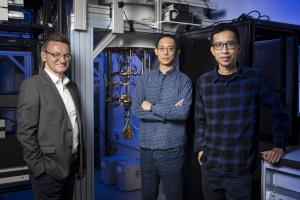Advanced quantum computer cooling techniques developed by Australian startup Diraq could lead to more powerful, cost-effective & energy-efficient systems sooner
In a peer-reviewed study published in Nature today, High-Fidelity Spin Qubit Operation and Algorithmic Initialisation Above 1K, the Diraq team demonstrate the capability of the company’s spin-based quantum processors to operate at temperatures 20 times warmer than previously demonstrated while maintaining stability and high accuracy.
Traditional silicon chips generate heat, a familiar issue when using electronic devices. Several leading quantum computing modalities in the current landscape require cooling to extremely low temperatures, very close to absolute zero (-273.15 °C). At higher temperatures, the qubits falter, rendering the technology impractical.
This new research demonstrates high-accuracy spin-based quantum computation at temperatures above one Kelvin, a temperature compatible with the ability of conventional electronics to operate, meaning it is possible to run complex error correction routines required for fault-tolerant quantum computing. This sets a path to realistic and useful quantum computers, according to Jonathan Huang, lead author and research associate at Diraq, and Ph.D. student at the University of New South Wales.
“This temperature increase, although difficult to grasp when compared to conventional temperature concepts, is actually groundbreaking in the realm of quantum computing,” said Huang. “Our advanced engineering achievement involved a deep understanding of physics as well as the experimental curiosity to push the boundaries of engineering design.”
Prior to this engineering milestone, the heat generated by controlling qubits presented a fundamental challenge to scaling quantum devices.
“The pioneering work of Huang and colleagues demonstrates a spin qubit platform that can operate at elevated temperatures, making it somewhat immune to the heat from control,” said David Reilly, Professor at the University of Sydney. “These results are also of significant practical importance, providing a means of characterising and screening devices without the need for expensive, complex dilution fridges.”
Addressing the scale-up challenge in quantum computing to reach millions of qubits, Diraq’s innovative hardware, which is constructed using a novel technology known as spins in silicon, sets the company apart from more established competitors, according to Professor Andrew Dzurak, CEO and Founder of Diraq.
“While our quantum processors still require refrigeration, the costs and complexity of the overall system are dramatically reduced at these elevated temperatures,” said Dzurak. “Harnessing the power of ‘hot qubits,’ these quantum computers will enable calculations far beyond the reach of supercomputers that exist today, enabling faster and more accurate predictions and analysis. This will also save costs and energy when running calculations to solve problems of global significance, generating significant economic outcomes.”
Dr. Henry Yang, Head of Quantum Control at Diraq, was lead author of the team’s previous paper[1], published in Nature in 2020 that created awareness of the challenges and opportunities of operating ‘hot qubits.’ Motivated by the challenge to achieve high accuracy qubit control, initialization and readout at elevated temperatures, Diraq undertook a meticulous exploration of physical parameters to reach its goal.
With a strategic vision to be an end-to-end quantum computing provider, Diraq aims to combine the value propositions of today’s chip manufacturers, cloud computing companies, and software algorithm providers to unlock the full potential of quantum computing – an industry projected to generate $450 to $850 Billion in value creation by 2040.
Quantum computing operates on principles distinct from classical computing, harnessing the power of minute quantum interactions to tackle large, complex problems. This intricate approach necessitates tailored algorithms, hardware and software specifically designed for quantum systems.
By leveraging modified transistors, the same fundamental components powering the digital devices integral to our daily lives, Diraq can use existing silicon chip ‘foundries’ for manufacture, tapping into decades of knowledge and trillions of dollars of investment that underpins today’s semiconductor industry.
The encoding of qubits in semiconductor spin carriers has been recognized as a promising approach to a commercial quantum computer that can be lithographically produced and integrated at scale.
Enabled by Diraq’s technological advancement, the transformative applications of quantum computing are expected to impact pharmaceuticals, materials science, finance, logistics, weather forecasting, and efficient management of energy storage and distribution.
[1] Yang, C. H., R. C. C. Leon, J. C. C. Hwang, A. Saraiva, T. Tanttu, W. Huang, J. Camirand Lemyre, et al. “Operation of a Silicon Quantum Processor Unit Cell above One Kelvin.” Nature 580, no. 7803 (April 2020): 350–54. https://doi.org/10.1038/s41586-020-2171-6.
About Diraq
Diraq is a world leader in building quantum processors using silicon ‘quantum dot’ technology, leveraging proprietary technology developed over 20 years of research and with over US $135 million in funding that has generated more than 50 patents worldwide, including funding from the Australian Research Council (ARC), UNSW Sydney, US Army Research Office (ARO) and the US Air Force Office of Scientific Research (AFOSR). This approach relies on the existing silicon manufacturing processes used by foundries to produce today’s semiconductor components, known as CMOS, forging a faster and cheaper road to market. Diraq’s goal is to revolutionize full-stack quantum computing by driving qubit numbers on a single chip to the many millions, and ultimately billions needed for useful commercial applications.
By capitalizing on existing chip fabrication technology and the ability to manufacture qubits at scale within existing semiconductor facilities, Diraq is accelerating the change that can transform computing as we know it today. Its platform architecture is purpose built to drive the significant processing advances required to reduce cost and energy barriers, and to realize quantum computing’s full societal and economic potential.
To learn more about Diraq and its quantum computing technology, visit diraq.com, or follow Diraq on LinkedIn, YouTube, and Twitter.
For media inquiries, please contact:
Mike Kilroy, Executive VP / Group Director, HKA Marketing Communications
mike@hkamarcom.com
Stefanie Tardo, Media Advisor, Diraq
media@diraq.com
Christian Balzora
HKA
+1 714-422-0919
email us here




